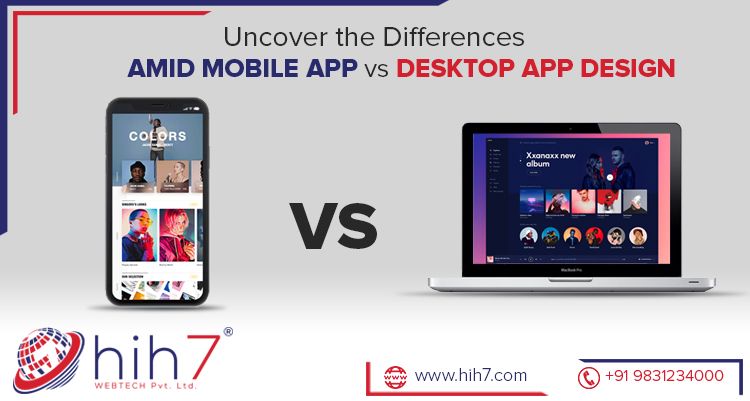With the advent of mobile apps in late 2013, the picture of the digital market changed dramatically. Internet usage of mobile apps surpassed the usage of desktop, and by the end of 2016 browsing using mobile apps stood first in contrast to desktop applications. Consequently, today desktop design has been replaced with
web and mobile app development and it has become a challenge for the marketers to flow with the flow, in order to be in pace with this digital evolution. Are you an entrepreneur and heading to start your own venture? In that case, you should first learn the
difference between desktop and mobile app design. As because, these allow you to shape out your business and reach out to the potential audience. Excited? Travel down the blog and you will able to make out the diversities.
1. Screen Size:
The very first visual difference that a layman too can understand is their screen size. Most of you may wonder, what's the use of adverting to this difference. Guys, this means a lot when it comes to design a mobile app. Screen size influences quite a number of aspects of design, that may include navigation, content prioritization etc.
Mobile app design includes a smaller screen size. This means less room for text, graphics, and other digital content. Isn't it? Well, is that mean you have to say 'no' to some graphics or information? Umm.. to some extent, yes. Designers while developing these mobile apps give priority to certain content, eliminating some graphics and all other irrelevant stuff.
Desktop app design, on the other hand, is far away from such a hassle. This can afford to incorporate its design with a wide range of digital content, instead of deferring them to other pages.
2. Interactions:
Today, almost every mobile device uses a touchscreen, that offers a different way of interaction to the users. Instead of clicking on a link or browsing with a cursor, users can easily tap their screen and interact with different interface elements. This is what is called gestures. So, as a designer, you need to keep this in mind that today interactions using cursors has been replaced with mobile gestures. Not sounding a bid deal? Nevertheless, this actually means a lot. Mobile apps may not allow you to hover or rollover, but you can easily get in touch with an endless slate of gestures, literally at your fingertips. Swiping, shaking, waving are the new trendy features of mobile apps.
3. Dropdown Menus:
One of the main differentiating elements of
mobile app vs desktop app design is the dropdown menus facility. Dropdown menus are quite feasible on a desktop but incorporating them on mobile apps is not less than a challenge. These menus are more appropriate or work better in a more user-friendly environment.
4. Organizing content:
As we said earlier, desktop format offers any content irrespective of size. This traditional multi-column format offers great flexibility for design layouts, images, and UI elements. Flipping the other side, mobile apps can't include wide contents and so they use the scrolling feature to make them visible. Amazing right? Nevertheless, the desktop screen also possesses the scrolling feature, but unlike mobile screen, you are allowed to use scroll bars to scroll down. Such a technology not only stockpile your screen space but also allow you to enjoy the fun with gestures. Additionally, mobile apps can be switched between portrait and landscape mode. This you can call it a curse or a blessing for the marketers. Why so? Twin modes may allow better functionality and user personalization, but on the other hand,
mobile app designers are pressurized to design twice (in both modes). Quite an exhausting work. Isn't it?
5. Integrated features:
Designing for mobile app includes a lot of integrated features, that actually act as a bonus for the marketers. These include direct calling, messaging, voice calls, and location functionalities. Additionally, you can entertain your customers with the exclusive gateways like virtual reality, augmented reality, multiple cameras, accelerometers and gyro sensors, and magnetic sensors. Will you get such direct features in your desktop app? Certainly not. These actually tailor your business with easier interactions and also enhance your visitor's experience. Our motive behind uncovering the difference between
mobile application and the desktop application is to make you realize that developing a mobile app should be your first priority. If you are heading to create both desktop and mobile app, you should go mobile first. As of today, a majority of digital users prefer more to browse their mobile apps than desktop applications. Especially, if you are about to create an e-commerce business app. Besides, you should have a sufficient knowledge of the prioritize elements or list down the design elements that you need for your
mobile apps development. Interested to bring down your website at your fingertips? Research on
professional mobile app developers. Remember, they know better than you, in all respects. Instead of digging out more problems, outsource your android app developing task to them. They will create a responsive, attractive, user-friendly, and most important SEO-friendly mobile application to serve your business needs. Developing websites and creating web or mobile apps are totally a different kettle of fish. Therefore, toeing the line above, we guess, will be quite beneficial for you. Furthermore, you should also take care of the fact that your
website design is compatible with your mobile speed. If not, then, unfortunately, you have to lose a number of customers. Are you done with your mobile app? Well, in that case, you should not forget
updating your website along with your mobile apps with the latest technology trends. After all, every new day a new technology is evolving and changing the market game. Hold on! We are not asking you to update your site or app daily. This is something freaky. But yes, you must renovate your site at least every three to four years.
